Air power seems like the perfect middle ground between a large ground force invasion and inaction: a way to hit the Islamic State hard while avoiding an Iraq-like quagmire. Yet air power has real limits, writes Dan Byman. This post originally appeared on Lawfare.
When it comes to the Islamic State, who doesn’t want to “bomb the shit out of them,” as our president-elect so eloquently put it? The group is violent, aggressive, and almost cartoonishly evil: torture, mass murder, and sexual slavery are only a few of the abhorrent practices the Islamic State embraces. Left unchecked, it may consolidate power and expand. After years of surviving largely underground, in 2014 it took over vast swaths of Iraq and Syria, and it has established so-called “provinces” in Afghanistan, Egypt, Libya, and other countries.
Bombing is attractive because Americans are rightly leery of a prolonged ground campaign in the Middle East. The Iraq debacle still colors our thinking on intervention. A poll taken in August showed that only 42 percent of Americans favored deploying a significant number of ground troops to Syria to fight the Islamic State, though a slight majority is comfortable with limited numbers of special operations forces.
Air power seems like the perfect middle ground between a large ground force invasion and inaction: a way to hit the Islamic State hard while avoiding an Iraq-like quagmire. The previously cited poll also showed that 72 percent of Americans favor airstrikes on the Islamic State, and apparently our president-elect is among their ranks. As Eliot Cohen, one of our country’s leading military analysts, once wryly remarked, “Air power is an unusually seductive form of military strength, in part because, like modern courtship, it appears to offer gratification without commitment.” Yet air power, if not used carefully, runs all the risks of a one-night stand: it can create false expectations, drag America into unwanted relationships with flawed partners, and winds up meaning little in the long-term.
Not surprisingly, in Iraq and Syria, the United States relies heavily on airpower to supplement Iraqi Security Forces, Peshmerga, Sunni tribal, and other militias to fight the Islamic State. Over the course of Operation Inherent Resolve’s two year life, Coalition aircraft (with the United States by far the largest contributor) have flown an estimated 125,000 sorties and destroyed or degraded around 32,000 targets—a massive effort. Air strikes also play an important role in Afghanistan, Somalia, Yemen, and other countries where the United States is fighting jihadist organizations.
Air power’s attractions are both clear and real. A sustained campaign of targeted killing using drones or fixed-wing aircraft can remove large numbers of terrorist leaders from the Islamic State’s ranks. Although killing one leader rarely has a decisive impact, the cumulative effects are considerable. Over time, veterans are weeded out and replaced by less experienced figures. At the very least, the constant transition in leadership is disruptive, as anyone who has worked in an office where bosses seem to rotate constantly can testify.
Perhaps most important, adaptation in response to air strikes renders terrorists less effective. A tip sheet found among jihadists in Mali advised militants they could avoid drones by maintaining “complete silence of all wireless contacts,” “[avoiding] gathering in open areas,” and taking strenuous measures to root out spies, and noted that leaders “should not use communications equipment,” among other suggestions. These are all sensible tips for avoiding death from above, but the implications for group effectiveness are staggering. Training on a large-scale is harder, if not impossible, as large gatherings can be lethal. Group leaders’ influence wanes, as they must hide or remain incommunicado. Trying to organize a kids’ soccer game, let alone a global terrorist network, becomes almost impossible if you can’t use phones or the Internet regularly. The indirect effects also matter. Islamic State leader Abu Bakr al-Baghdadi has been laying low since U.S. military operations began, diminishing his charismatic presence from Islamic State propaganda and, presumably, disheartening his beleaguered troops. Abu Mohammad al-Adnani, the spokesman who headed the group’s external operations, was also charismatic and inspired terrorists around the world to attack—and eventually the United States tracked him down and killed him in an airstrike.
Politically, air power is also attractive, and it is not surprising politicians as diverse as Donald Trump, Barack Obama, George W. Bush, and Bill Clinton found it appealing. When drones crash or are shot down, the pilot still lives. Pilots of fixed-wing aircraft, of course, take on more risk, but the combination of terrorists’ weak air defenses and the sophisticated aircraft U.S. pilots fly often limit this danger considerably. Because few or no American lives are at risk, U.S. leaders can intervene with less concern about the political costs at home.
Air power is particularly valuable when it can be yoked with local allied fighters on the ground. In Afghanistan after 9/11, the rag-tag Northern Alliance quickly turned the tables on the Taliban after the U.S. Air Force entered the fray. NATO airpower stopped Gadhafi’s forces at the gates of Benghazi and then helped the Libyan opposition push back regime forces and eventually gain victory. When local fighters support air power—and vice versa—enemy forces find it hard to maneuver and mass: when they do, they risk being destroyed. This puts them on the defensive, enabling allied militaries or militias to isolate terrorist fighters. Air power plays a role in crushing these isolated forces too, helping support ground operations, even in relatively built up areas.
Urban environments present significantly greater challenges for targeting and minimizing civilian casualties, yet the U.S. has still identified and destroyed hundreds of Islamic State fighting positions, fortified buildings, vehicles, and equipment in the support of the Mosul offensive. In the first week of the offensive alone, coalition air power conducted around 100 airstrikes in and around the city. As the Iraqi forces approached the city’s outskirts, Islamic State defenders were subjected to strikes every eight minutes during one three-day period. U.S. airpower continues to be critical in enabling even minor tactical advances against the Islamic State to the point of near dependency, which some observers, including my colleague Kenneth Pollack, warn could overstretch even the relatively substantial coalition effort.
Yet air power has real limits.
For it to be effective, for starters, certain preconditions must be met. Bombers need bases near the conflict zone and access to the battlefield. True, some systems can fly bombing runs all the way from the United States. But to maintain a sustained battlefield presence, aircraft must be able to get to and from the conflict zone quickly and easily. Allies, of course, don’t provide access to their bases for free: they expect favors in return. Current armed drone systems also need a permissive environment, as they are simply too easy to shoot down otherwise. Thus, the United States either needs local governments to cooperate with drone strikes or the absence of an effective government (and thus the absence of air defenses).
Nor does air power address the biggest long-term challenges in fighting the Islamic State: governance. The United States has proven again and again that it can dislodge terrorists, insurgents, and forces loyal to local despots. Filling the vacuum so that they don’t return is much harder. The terrorists often come back, or, at times, chaos rules. Neither outcome is an improvement for locals, and new terrorist groups can breed if there is no government to keep them down. You can’t provide that governance with a drone.
Moreover, for air power to be effective, you need capable local allies. Their forces can provide the necessary intelligence to find and target Islamic State fighters. In addition, when they advance, they force Islamic State forces to mass—making them vulnerable to air power. If Islamic State fighters stay dispersed and hidden, then forces on the ground can root them out. Local forces can also fill the vacuum after victory, ideally establishing a legitimate government and preventing the terrorists from returning or new extremist groups from arising.
The trouble is that local allies are often themselves flawed instruments: corrupt, ineffective, and brutal. Often, U.S. troops are necessary to leaven local forces, provide necessary intelligence, and otherwise carry much of the burden.
Finally, by using air power, the United States becomes implicated in the local conflict. Bombing “the shit out of” the bad guys leaves an impression on more than just the bad guys. Although from a U.S. perspective the current intervention seems limited and low-risk, the perception may be different on the ground. The United States has taken sides in a war, and Washington’s partnership with local forces means locals do not always distinguish between more precise U.S. air strikes and more brutal and indiscriminate attacks from allied militias and forces.
Like all good things except sex and barbeque, in other words, air power is best in moderation. It can keep the bad guys off balance, tilt the playing field in favor of U.S. allies, and otherwise help in the fight against terrorism. But it is an imperfect instrument even when it works well, and absent other tools and a broader strategy its benefits will always be limited.
The Brookings Institution is committed to quality, independence, and impact.
We are supported by a diverse array of funders. In line with our values and policies, each Brookings publication represents the sole views of its author(s).


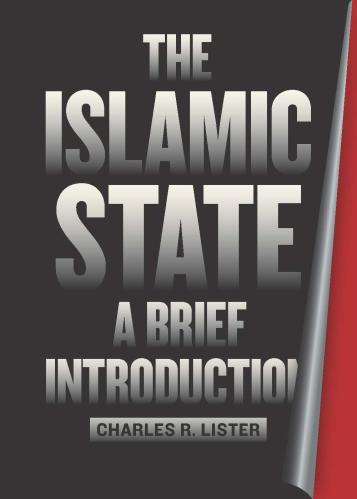
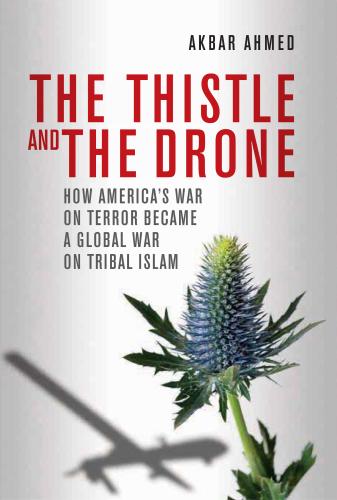
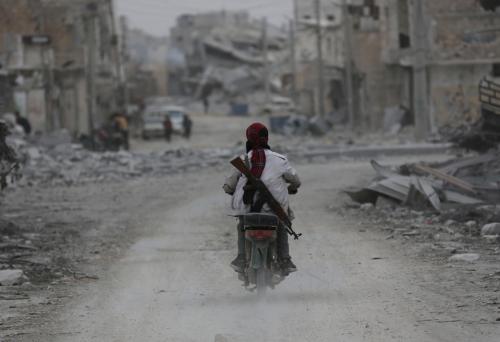
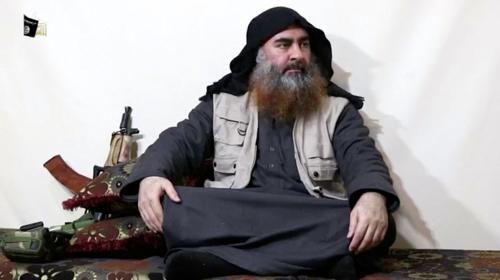
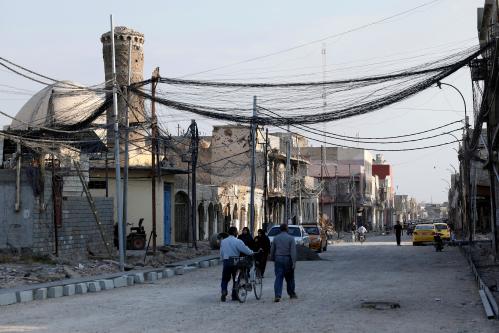



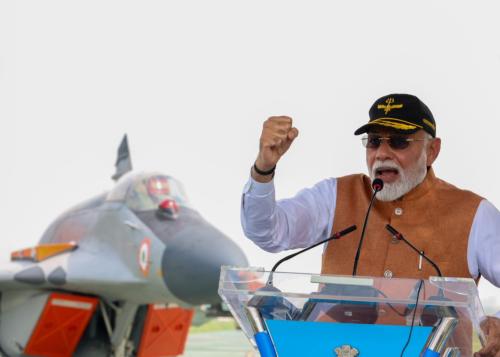
Commentary
The limits of air strikes when fighting the Islamic State
December 6, 2016